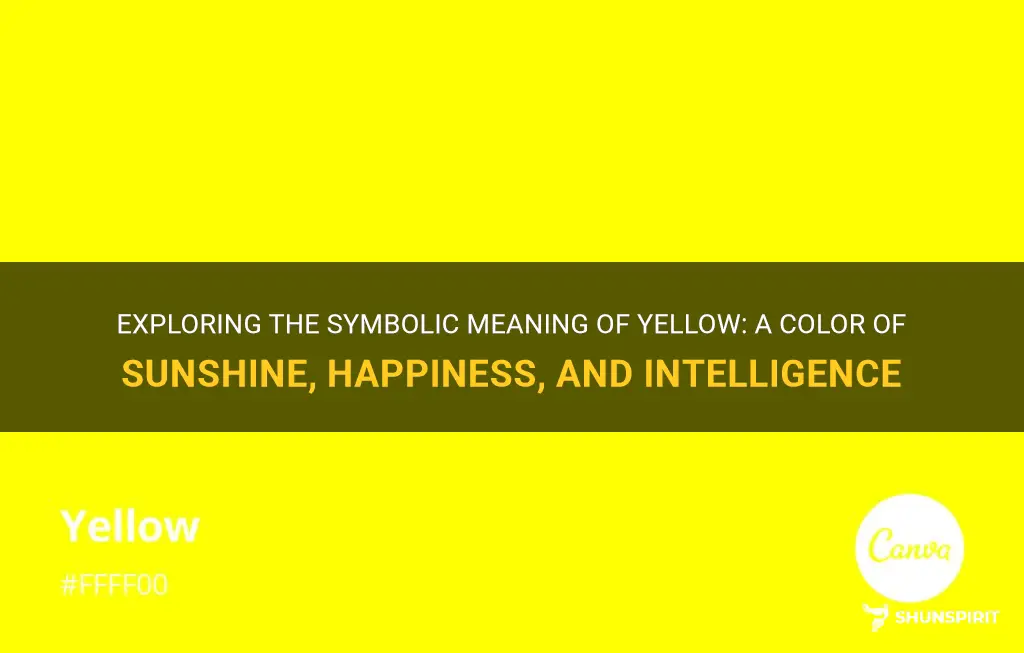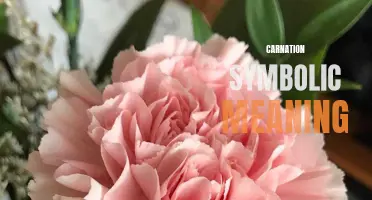
Yellow is a color that is often associated with the sun, warmth, and happiness. It is a color that stands out and grabs attention, evoking feelings of joy and positivity. In many cultures, yellow is also considered to be a symbol of wisdom, intellect, and enlightenment. From golden sunflowers to bright canaries, yellow is a color that is often used to represent light and optimism. Whether it is used in art, fashion, or design, yellow has a way of adding a vibrant and energetic touch. So, whenever you see the color yellow, let it remind you to embrace the bright side of life and bask in the warmth it has to offer.
What You'll Learn
- What is the symbolic meaning of the color yellow in different cultures and traditions?
- How does the color yellow symbolize happiness and positivity?
- What role does yellow play in symbolism related to caution and warning signs?
- Can you provide examples of famous artworks or literature where the color yellow holds symbolic meaning?
- Does the symbolic meaning of yellow vary depending on its shade or tint?

What is the symbolic meaning of the color yellow in different cultures and traditions?
The color yellow has a vibrant and powerful symbolism in various cultures and traditions around the world. It is often associated with positive attributes such as happiness, joy, warmth, and enlightenment. In many cultures, yellow is also seen as a color that represents wealth, power, and royalty. Let's explore the symbolic meanings of the color yellow in different cultures and traditions.
In Western cultures, yellow often represents optimism and cheerfulness. It is associated with qualities such as happiness, positivity, and energy. The color yellow is often used to bring a sense of warmth and brightness to spaces, hence it is commonly used in home decor, clothing, and branding.
In many African cultures, yellow is seen as representing wealth and fertility. In some traditions, yellow is worn during celebrations and ceremonies to symbolize abundance and prosperity. Yellow is also considered a color of royalty and power in African cultures, often associated with precious metals like gold.
In Eastern cultures, such as China and Japan, yellow is associated with good luck, fortune, and happiness. In China, yellow is the symbol of the emperor and was historically reserved for royalty. It is a color that represents power, prestige, and authority. In Japan, yellow is often associated with optimism and courage.
In Hinduism, yellow is considered an auspicious color and is associated with knowledge and learning. In religious ceremonies and rituals, yellow is often used to represent the divine and spiritual aspects of life. Yellow clothing is also worn during festivals and celebrations in Hindu culture.
In Native American cultures, yellow is often associated with the sun and is seen as symbolizing vitality, life, and energy. The Hopi tribe, for example, uses yellow as a symbol of the North and embraces it as a color of healing and growth.
In the realm of psychology and color therapy, yellow is known to have an energizing effect on people. It is believed to stimulate mental activity, boost creativity, and increase overall happiness.
Overall, the symbolic meaning of the color yellow varies across cultures and traditions, but it generally represents positive qualities such as happiness, warmth, wealth, and power. Whether it is used to bring cheerfulness to a space, symbolize royalty, or invoke good luck, yellow holds an important place in many cultures and continues to be a color of significance.
Unraveling the Mysteries of Kryptonian Symbols and Their Hidden Meanings
You may want to see also

How does the color yellow symbolize happiness and positivity?
The color yellow is often associated with happiness and positivity. This can be seen in various aspects of life, from the effect it has on our mood to the symbolism it carries in different cultures and contexts. Understanding why yellow is linked to happiness can help us appreciate the power of color in influencing our emotions and overall well-being.
One reason why yellow is often associated with happiness is its resemblance to the sun. The sun is a universal symbol of warmth, light, and energy, and these qualities are often attributed to yellow as well. Just as the sun brings light and life to the world, yellow is seen as a color that brings joy and optimism. Its brightness and vibrancy can instantly uplift our spirits and create a sense of positivity.
Yellow is also associated with the natural world, particularly with flowers such as sunflowers and daffodils. These flowers are often seen as symbols of happiness and joy due to their bright yellow color. Additionally, the yellow color of these flowers is often associated with spring and new beginnings, further reinforcing the connection between yellow and positivity.
In various cultures, yellow is seen as a color of prosperity and good luck. In China, for example, yellow is the color of the emperor and is associated with power and wealth. In Indian culture, yellow is seen as a color that symbolizes purity and spirituality. These cultural associations further enhance the positive connotations of the color yellow.
The psychological impact of the color yellow is also worth noting. Yellow is believed to have a stimulating effect on our mental processes and can promote feelings of happiness and optimism. Studies have shown that exposure to yellow can increase levels of serotonin, a neurotransmitter associated with mood regulation. This can explain why yellow is often used in interior design and advertising to create a positive and uplifting environment.
In conclusion, the color yellow symbolizes happiness and positivity due to its resemblance to the sun, its association with flowers and nature, its cultural connotations, and its psychological impact. Whether it is the bright yellow of the sun, the cheery yellow of flowers, or the lucky yellow of cultural symbolism, this color has the power to bring joy and optimism into our lives. Incorporating yellow into our surroundings or even wearing yellow clothing can help uplift our mood and create a positive atmosphere. So, embrace the power of yellow and let it bring a little extra happiness into your life.
Decoding the Mysteries: Nissan Car Symbols and Their Meanings
You may want to see also

What role does yellow play in symbolism related to caution and warning signs?
Yellow is a color that is often associated with caution and warning signs. Its bright and vibrant hue is easily visible, making it the perfect choice for conveying important information and alerting people to potential dangers. In various cultures and contexts, yellow has come to symbolize caution, warning, and the need to exercise caution in certain situations.
One common application of yellow in symbols related to caution and warning signs is in road signs. Yellow is used to warn drivers of potential hazards, such as sharp curves, pedestrian crossings, and road construction zones. These signs are designed to catch drivers' attention and prompt them to slow down and proceed with caution. The bright and bold yellow color stands out against the background, making it effective in getting the message across quickly and clearly.
The use of yellow in caution and warning signs extends beyond road signs. In everyday life, yellow is often used to symbolize caution or the need to be careful. For example, yellow caution tape is often used to cordon off areas that are deemed unsafe or off-limits to the public. This serves as a visual reminder for people to proceed with caution and avoid potential danger.
In addition to its association with caution, yellow is also linked to warning signs in certain contexts. In industrial and commercial settings, yellow is often used to indicate areas where safety precautions are required. For example, yellow warning signs may be placed near chemical storage areas or construction sites to warn employees and visitors about potential hazards.
The symbolism of yellow as a cautionary color can be traced back to its psychological effects on human perception. Yellow is a high-visibility color that naturally attracts attention. Its brightness and intensity make it stand out, making it an effective choice for capturing people's attention and conveying important messages. The eye-catching nature of yellow makes it hard to ignore, ensuring that people take notice and exercise caution when encountering yellow warning signs.
In conclusion, yellow plays a significant role in symbolism related to caution and warning signs. Its bright and vibrant color makes it easily visible and attention-grabbing, which is essential for conveying important information and alerting people to potential dangers. Whether it is used in road signs, caution tape, or warning signs in industrial settings, yellow serves as a visual reminder for individuals to exercise caution and be aware of their surroundings. Next time you see a yellow caution or warning sign, remember its significance in conveying important safety information.
Unearthing the Secrets of Stone Age Cave Art: Decoding the Symbols and Meanings
You may want to see also

Can you provide examples of famous artworks or literature where the color yellow holds symbolic meaning?
Yellow is a color that holds various symbolic meanings in the world of art and literature. It is often associated with warmth, positivity, and happiness. In this article, we will explore some famous artworks and literature where the color yellow plays a significant role and carries symbolic meaning.
One of the most well-known examples of the color yellow holding symbolism in art is Vincent van Gogh's painting, "The Starry Night". In this iconic artwork, Van Gogh uses vibrant yellow swirls to depict the night sky. The color yellow represents a sense of energy and vitality, contrasting with the darker blues and greens, which symbolize the calmness and tranquility of the night. Through the use of yellow, Van Gogh conveys a feeling of hope and optimism despite the darkness.
Another famous work where yellow carries symbolic meaning is F. Scott Fitzgerald's novel, "The Great Gatsby". In this classic American novel, the color yellow is associated with wealth and decadence. The character of Daisy Buchanan is often portrayed wearing yellow dresses, which represent her materialistic and superficial nature. The color yellow in this context symbolizes the corruptive power of money and the illusion of the American Dream.
Yellow also holds symbolic meaning in religious and spiritual texts. In Buddhism, the color yellow is associated with the middle path, which is the balanced state between extremes. The Yellow River in China is considered sacred and holds symbolic importance in Taoism, representing the flow of life and energy. In Hinduism, yellow is associated with knowledge and learning, as well as the solar deity Surya.
Pablo Picasso's painting, "Les Demoiselles d'Avignon," is another example where yellow holds symbolic meaning. The painting depicts five nude women in a brothel, and the use of yellow represents the menacing and aggressive nature of their gazes. Yellow in this context symbolizes danger and intensity, contrasting with the traditional association of yellow with positivity and happiness.
In literature, Arthur Miller's play, "The Crucible," utilizes yellow as a symbol of suspicion and accusation. The yellow bird, often mentioned throughout the play, represents the witchcraft hysteria and the paranoia that spreads throughout the community. Yellow symbolizes the fear and uncertainty that grips the characters as they accuse each other of practicing witchcraft.
In conclusion, the color yellow is a powerful symbol in various forms of art and literature. It can represent hope, wealth, corruption, danger, and even spirituality. Artists and authors use the color yellow strategically to convey certain emotions, themes, or messages within their works. By understanding the symbolism behind the color yellow, we can gain a deeper appreciation for the art and literature that incorporates this vibrant hue.
Exploring the Symbolism and Meanings of Norwegian National Symbols
You may want to see also

Does the symbolic meaning of yellow vary depending on its shade or tint?
Yellow is a vibrant and lively color that is often associated with happiness, energy, and optimism. However, the symbolic meaning of yellow can vary depending on its shade or tint. Different shades of yellow can evoke different emotions and have different associations.
Light or pale yellow is often associated with joy, freshness, and youth. It can symbolize a sunny and positive outlook on life. Light yellow is often used to represent springtime and new beginnings. It can also convey a sense of innocence and clarity. This shade of yellow is commonly used in baby nurseries and children's rooms to create a cheerful and uplifting atmosphere.
On the other hand, a bright or vibrant yellow can symbolize enthusiasm, creativity, and confidence. It is often associated with sunshine and warmth. This shade of yellow can be attention-grabbing and eye-catching, making it ideal for advertising and marketing. It can also represent happiness, excitement, and a zest for life. Bright yellow is often used to create a bold and energetic atmosphere.
Another shade of yellow that has a different symbolic meaning is mustard yellow. This shade is darker and has a more muted and earthy tone. It is often associated with autumn and the changing of seasons. Mustard yellow can represent warmth, comfort, and a sense of groundedness. This shade of yellow is often used in fashion and interior design to create a cozy and inviting atmosphere.
In addition to shades of yellow, the tint or intensity of yellow can also affect its symbolic meaning. A soft and pastel tint of yellow can evoke a sense of serenity, calmness, and tranquility. It is often associated with the color of flowers and can symbolize femininity and tenderness. On the other hand, a bold and intense tint of yellow can represent energy, power, and strength. It can be used to create a sense of excitement and dynamism.
Overall, the symbolic meaning of yellow can vary depending on its shade or tint. Light or pale yellow can represent joy and freshness, while a bright or vibrant yellow can symbolize enthusiasm and creativity. Mustard yellow can evoke warmth and comfort, while pastel yellow can represent serenity and calmness. The intensity or tint of yellow can also affect its symbolic meaning, with softer tints representing femininity and tenderness, and bold tints representing energy and strength. Regardless of the specific shade or tint, yellow is a color that is often associated with positivity, happiness, and optimism.
Frequently asked questions
Yellow is often associated with happiness, joy, and energy. It is a color that represents optimism and positivity. Yellow is also linked to intelligence and creativity, as it is thought to stimulate the mind and promote mental clarity. Additionally, yellow is associated with warmth and sunshine, giving it a comforting and uplifting connotation.
In many cultures, yellow holds various symbolic meanings. For example, in Western cultures, yellow is often associated with caution and warnings, particularly when used in road signs and traffic signals. In some Eastern cultures, yellow is a symbol of spirituality and enlightenment. Chinese culture sees yellow as a symbol of royalty and power, while in India, it is associated with the divine and spiritual. Overall, cultural meanings of yellow can vary widely depending on the context and society.
Yellow is known to have a stimulating effect on our emotions. It can evoke feelings of happiness, cheerfulness, and optimism. The bright and vibrant nature of yellow can help boost mood and energy levels, making it a great color choice for spaces where creativity and productivity are desired. However, too much yellow can be overwhelming and may lead to feelings of anxiety or distraction for some individuals. It is important to strike a balance when incorporating yellow into our surroundings.
Yellow is commonly used in a variety of symbolic contexts. In nature, yellow often represents sunlight, warmth, and energy. It can be seen in the vibrant hues of flowers, fruits, and landscapes, symbolizing growth and vitality. In the world of psychology, yellow is associated with clarity of thought, communication, and intellect. Yellow is also used symbolically in political and social contexts, often representing caution, warnings, or activism. From advertising to branding, yellow is frequently used to catch attention and evoke positive emotions in viewers.







